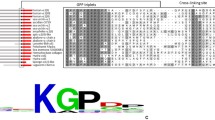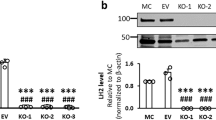Abstract
Collagens represent a large family of structurally related proteins containing a unique triple-helical structure. Among them, the fibril-forming collagens are the most abundant in vertebrates providing tissues with form and stability. One of the characteristics of the fibrillar collagens is its sequential posttranslational modifications of specific lysine residues that have major effects on molecular assembly and stability of the fibrils in the extracellular space. Hydroxylation of lysine residues is the first modification catalyzed by lysyl hydroxylases, and is critical for the following glycosylation and in determining the fate of covalent cross-linking. This chapter presents an overview of lysine hydroxylation and cross-linking of collagen, and the analytical methods we have developed.
Access this chapter
Tax calculation will be finalised at checkout
Purchases are for personal use only
Similar content being viewed by others
References
Myllyharju J, Kivirikko KI (2004) Collagens, modifying enzymes and their mutations in humans, flies and worms. Trends Genet 20:33–43
Yamauchi M, Sricholpech M (2012) Lysine post-translational modifications of collagen. Essays Biochem 52:113–133
Kivirikko KI, Myllylä R (1982) Posttranslational enzymes in the biosynthesis of collagen: intracellular enzymes. Methods Enzymol 82:245–304
Berg RA, Prockop DJ (1973) The thermal transition of a non-hydroxylated form of collagen. Evidence for a role for hydroxyproline in stabilizing the triple-helix of collagen. Biochem Biophys Res Commun 52:115–120
Miller EJ (1984) Chemistry of the collagens and their distribution. In: Piez KA, Reddi AH (eds) Extracellular matrix biochemistry. Elsevier, New York, NY
Royce PM, Barnes MJ (1985) Failure of highly purified lysyl hydroxylase to hydroxylate lysyl residues in the non-helical regions of collagen. Biochemist 230:475–480
Gerriets JE, Curwin SL, Last JA (1993) Tendon hypertrophy is associated with increased hydroxylation of nonhelical lysine residues at two specific cross-linking sites in Type I collagen. J Biol Chem 268:25553–25560
Valtavaara M, Papponen H, Pirttila¨ A-M, Hiltunen K, Helander H, Myllyla¨ R (1997) Cloning and characterization of a novel human lysyl hydroxylase isoform highly expressed in pancreas and muscle. J Biol Chem 272:6831–6834
Valtavaara M, Valtavaara M, Szpirer C, Szpirer J, Myllyla R (1998) Primary structure, tissue distribution, and chromosomal localization of a novel isoform of lysyl hydroxylase (lysyl hydroxylase 3). J Biol Chem 273:12881–12886
Yeowell HN, Walker LC (1999) Tissue specificity of a new splice form of the human lysyl hydroxylase 2 gene. Matrix Biol 18:179–187
Uzawa K, Grzesik WJ, Nishiura T, Kuzetsov SA, Robey PG, Brenner DA, Yamauchi M (1999) Differential expression of human lysyl hydroxylase genes, lysine hydroxylation, and cross-linking of type i collagen during osteoblastic differentiation in vitro. J Bone Miner Res 14:1272–1280
Pornprasertsuk S, Duarte WR, Mochida Y, Yamauchi M (2004) Lysyl hydroxylase-2b directs collagen cross-linking pathways in MC3T3-E1 cells. J Bone Miner Res 19:1349–1355
Bank RA, Robins SP, Wijmenga C, Breslau-Siderius LJ, Bardoel AFJ, Sluijs HAVD, Pruijs HE, Tekoppele JM (1999) Defective collagen crosslinking in bone, but not in ligament or cartilage, in Bruck syndrome: indications for a bone-specific telopeptide lysyl hydroxylase on chromosome 17. Proc Natl Acad Sci U S A 96:1054–1058
van der Slot AJ, Zuurmond AM, van den Bogaerdt AJ, Ulrich MMW, Middelkoop E, Boers W, Ronday HK, DeGroot J, Huizinga TWJ, Bank RA (2004) Increased formation of pyridinoline cross-links due to higher telopeptide lysyl hydroxylase levels is a general fibrotic phenomenon. Matrix Biol 23:251–257
Ha-Vinh R, Alanay Y, Bank RA, Campos-Xavier AB, Zankl A, Superti-Furga A, Bonafe L (2004) Phenotypic and molecular characterization of Bruck syndrome (osteogenesis imperfecta with contractures of the large joints) caused by a recessive mutation in PLOD2. Am J Med Genet A 131:115–120
Mercer DK, Nicol PF, Kimbembe C, Robins SP (2003) Identification, expression, and tissue distribution of the three rat lysyl hydroxylase isoforms. Biochem Biophys Res Commun 307:803–809
Pornprasertsuk S, Duarte WR, Mochida Y, Yamauchi M (2005) Overexpression of lysyl hydroxylase-2b leads to defective collagen fibrillogenesis and matrix mineralization. J Bone Miner Res 20:81–87
Gilkes DM, Bajpai S, Wong CC, Chaturvedi P, Hubbi ME, Wirtz D, Semenza GL (2013) Procollagen lysyl hydroxylase 2 is essential for hypoxia-induced breast cancer metastasis. Mol Cancer Res 11:456–466
Eisinger-Mathason TS, Zhang M, Qiu Q, Skuli N, Nakazawa MS, Karakasheva T, Mucaj V, Shay JE, Stangenberg L, Sadri N, Pure E, Yoon SS, Kirsch DG, Simon MC (2013) Hypoxia-dependent modification of collagen networks promotes sarcoma metastasis. Cancer Discov 3:1190–1205
Chen Y, Terajima M, Yang Y, Sun L, Ahn Y-H, Pankova D, Puperi DS, Watanabe T, Kim MP, Blackmon SH, Rodriguez J, Liu H, Behrens C, Wistuba II, Minelli R, Scott KL, Sanchez-Adams J, Guilak F, Pati D, Thilaganathan N, Burns AR, Creighton CJ, Martinez ED, Zal T, Grande-Allen KJ, Yamauchi M, Kurie JM (2015) Lysyl hydroxylase 2 induces a collagen cross-link switch in tumor stroma. J Clin Invest 125:1147–1162
Chen Y, Guo H, Terajima M, Banerjee P, Liu X, Yu J, Momin AA, Katayama H, Hanash SM, Burns AR, Fields GB, Yamauchi M, Kurie JM (2016) Lysyl hydroxylase 2 is secreted by tumor cells and can modify collagen in the extracellular space. J Biol Chem 291:25799–25808
Pankova D, Chen Y, Terajima M, Schliekelman MJ, Baird BN, Fahrenholtz M, Sun L, Gill BJ, Vadakkan TJ, Kim MP, Ahn YH, Roybal JD, Liu X, Parra Cuentas ER, Rodriguez J, Wistuba II, Creighton CJ, Gibbons DL, Hicks JM, Dickinson ME, West JL, Grande-Allen KJ, Hanash SM, Yamauchi M, Kurie JM (2016) Cancer-associated fibroblasts induce a collagen cross-link switch in tumor stroma. Mol Cancer Res 14:287–295
Sada M, Ohuchida K, Horioka K, Okumura T, Moriyama T, Miyasaka Y, Ohtsuka T, Mizumoto K, Oda Y, Nakamura M (2016) Hypoxic stellate cells of pancreatic cancer stroma regulate extracellular matrix fiber organization and cancer cell motility. Cancer Lett 372:210–218
Myllylä R, Wang C, Heikkinen J, Juffer A, Lampela O, Risteli M, Ruotsalainen H, Salo A, Sipilä L (2007) Expanding the lysyl hydroxylase toolbox: new insights into the localization and activities of lysyl hydroxylase 3 (LH3). J Cell Physiol 212:323–329
Schegg B, Hulsmeier AJ, Rutschmann C, Maag C, Hennet T (2009) Core glycosylation of collagen is initiated by two beta(1-O)galactosyltransferases. Mol Cell Biol 29:943–952
Sricholpech M, Perdivara I, Nagaoka H, Yokoyama M, Tomer KB, Yamauchi M (2011) Lysyl hydroxylase 3 glucosylates galactosylhydroxylysine residues in type I collagen in osteoblast culture. J Biol Chem 286:8846–8856
Sricholpech M, Perdivara I, Yokoyama M, Nagaoka H, Terajima M, Tomer KB, Yamauchi M (2012) Lysyl hydroxylase 3-mediated glucosylation in type i collagen: molecular loci and biological significance. J Biol Chem 287:22998–23009
Ishikawa Y, Vranka JA, Boudko SP, Pokidysheva E, Mizuno K, Zientek K, Keene DR, Rashmir-Raven AM, Nagata K, Winand NJ, Bachinger HP (2012) Mutation in cyclophilin B that causes hyperelastosis cutis in American Quarter Horse does not affect peptidylprolyl cis-trans isomerase activity but shows altered cyclophilin B-protein interactions and affects collagen folding. J Biol Chem 287:22253–22265
Terajima M, Taga Y, Chen Y, Cabral WA, Hou-Fu G, Srisawasdi S, Nagasawa M, Sumida N, Hattori S, Kurie JM, Marini JC, Yamauchi M (2016) Cyclophilin-B modulates collagen cross-linking by differentially affecting lysine hydroxylation in the helical and telopeptidyl domains of tendon type I collagen. J Biol Chem 291:9501–9512
Gjaltema RA, van der Stoel MM, Boersema M, Bank RA (2016) Disentangling mechanisms involved in collagen pyridinoline cross-linking: the immunophilin FKBP65 is critical for dimerization of lysyl hydroxylase 2. Proc Natl Acad Sci U S A 113(26):7142–7147
Ishikawa Y, Boudko S, Bachinger HP (2015) Ziploc-ing the structure: Triple helix formation is coordinated by rough endoplasmic reticulum resident PPIases. Biochim Biophys Acta 1850:1983–1993
Tanzer ML (1973) Cross-linking of collagen. Science 180:561–566
Molnar J, Fong KSK, He QP, Hayashi K, Kim Y, Fong SFT, Fogelgren B, Molnarne Szauter K, Mink M, Csiszar K (2003) Structural and functional diversity of lysyl oxidase and LOX-like proteins. Biochim Biophys Acta 1647:220–224
Atsawasuwan P, Mochida Y, Parisuthiman D, Yamauchi M (2005) Expression of lysyl oxidase isoforms in MC3T3-E1 osteoblastic cells. Biochem Biophys Res Commun 327:1042–1046
Yamauchi M, London RE, Guenat C, Hashimoto F, Mechanic GL (1987) Structure and formation of a stable histidine-based trifunctional cross-link in skin collagen. J Biol Chem 262:11428–11434
Mechanic GL, Katz EP, Henmi M, Noyes C, Yamauchi M (1987) Locus of a histidine-based, stable trifunctional, helix to helix collagen cross-link: stereospecific collagen structure of Type I skin fibrils. Biochemistry 26:3500–3509
Yamauchi M, Chandler GS, Tanzawa H, Katz EP (1996) Cross-linking and the molecular packing of corneal collagen. Biochem Biophys Res Commun 219(2):311–315
Eyre DR (1984) Cross-linking in collagen and elastin. Annu Rev Biochem 53:717–748
Kuypers R, Tyler M, Kurth LB, Jenkins ID, Horgan DJ (1992) Identification of the loci of the collagen-associated Ehrlich chromogen in type I collagen confirms its role as a trivalent cross-link. Biochem J 283:129–136
Hanson DA, Eyre DR (1996) Molecular site specificity of pyridinoline and pyrrole cross-links in type I collagen of human bone. J Biol Chem 271:26508–26516
Bailey AJ, Paul RG, Knott L (1998) Mechanisms of maturation and ageing of collagen. Mech Ageing Dev 106:1–56
Yamauchi M, Mechanic GL (1988) Cross-linking of collagen. In: Nimni ME (ed) Collagen. CRC Press, Boca Raton, FL, pp 157–172
Robins SP (1982) Analysis of the crosslinking components in collagen and elastin. Methods Biochem Anal 28:329–379
Yamauchi M, Katz EP, Mechanic GL (1986) Intermolecular cross-linking and stereospecific molecular packing in type I collagen fibrils of the periodontal ligament. Biochemistry 25:4907–4913
Yamauchi M, Katz EP (1993) The post-translational chemistry and molecular packing of mineralizing tendon collagens. Connect Tissue Res 29:81–98
Uzawa K, Yeowell HN, Yamamoto K, Mochida Y, Tanzawa H, Yamauchi M (2003) Lysine hydroxylation of collagen in a fibroblast cell culture system. Biochem Biophys Res Commun 305:484–487
Saito M, Soshi S, Tanaka T, Fujii K (2004) Intensity-related differences in collagen post-translational modification in MC3T3-E1 osteoblasts after exposure to low- and high-intensity pulsed ultrasound. Bone 35:644–655
Yamamoto K, Yamauchi M (1999) Characterization of dermal type I collagen of C3H mouse at different stages of the hair cycle. Br J Dermatol 141:667–675
Acknowledgments
This study was originally supported by NIH grants DE10489 and AR052824 and NASA grant NAG2-1596.
Author information
Authors and Affiliations
Corresponding author
Editor information
Editors and Affiliations
Rights and permissions
Copyright information
© 2019 Springer Science+Business Media, LLC, part of Springer Nature
About this protocol
Cite this protocol
Yamauchi, M., Terajima, M., Shiiba, M. (2019). Lysine Hydroxylation and Cross-Linking of Collagen. In: Kannicht, C. (eds) Post-Translational Modification of Proteins. Methods in Molecular Biology, vol 1934. Humana, New York, NY. https://doi.org/10.1007/978-1-4939-9055-9_19
Download citation
DOI: https://doi.org/10.1007/978-1-4939-9055-9_19
Published:
Publisher Name: Humana, New York, NY
Print ISBN: 978-1-4939-9053-5
Online ISBN: 978-1-4939-9055-9
eBook Packages: Springer Protocols




